Abstract
Since second-order statistics-based methods rely heavily on Gaussianity assumption and fractional lower-order statistics-based methods depend on a priori knowledge of non-Gaussian noise, there remains a void in wideband bistatic multiple-input/multiple-output (MIMO) radar systems under impulsive noise. In this paper, a novel method based on Sigmoid transform was used to estimate target parameters, which do not need a priori knowledge of the noise in an impulsive noise environment. Firstly, a novel wideband ambiguity function, termed Sigmoid wideband ambiguity function (Sigmoid-WBAF), is proposed to estimate the Doppler stretch and time delay by searching the peak of the Sigmoid-WBAF. A novel Sigmoid correlation function is proposed. Furthermore, a new MUSIC algorithm based on the Sigmoid correlation function (Sigmoid-MUSIC) is proposed to estimate the direction-of-departure (DOD) and direction-of-arrival (DOA). Then, the boundness of the Sigmoid-WBAF to the symmetric alpha stable () noise, the feasibility analysis of the Sigmoid-WBAF, and complexity analysis of the Sigmoid-WBAF and Sigmoid-MUSIC are presented to evaluate the performance of the proposed method. In addition, the Cramér–Rao bound for parameter estimation was derived and computed in closed form, which shows that better performance was achieved. Simulation results and theoretical analyses are presented to verify the effectiveness of the proposed method.
1. Introduction
Recently, multiple-input/multiple-output (MIMO) systems attracted more and more attention [1,2,3]. There is rapidly growing literature concerning target parameter estimation in MIMO radar systems. Generally, target parameter estimation algorithms can be used in both narrowband and wideband MIMO radar systems. In narrowband MIMO radar systems, Yoe et al. proposed a computationally efficient method using properly designed projection filters to estimate the direction-of-departure (DOD) and direction-of-arrival (DOA) of targets [4]. Chen et al. proposed a method based on ESPRIT using the rotational factor produced by time-delay sampling to estimate the Doppler, DOD, and DOA [5]. Yao et.al. proposed a novel estimation method based on a non-uniform array configuration to estimate the DOD and DOA parameters, and analyzed their practical identifiability [6]. Jiang et al. proposed a joint estimation algorithm based on the canonical correlation decomposition (CCD) and exploits the shift-invariance properties in the Kronecker product structure of each column of the various steering matrices in unknown correlated noise [7]. Some improved algorithms based on MUSIC and ESPRIT were also proposed to estimate DOD and DOA parameters [8,9,10]. These methods were shown to yield good performance in terms of their parameters. In many applications, however, it is not appropriate to approximate the signal using a narrowband model.
In wideband radar systems, the echo from a wideband signal often contains a Doppler stretch (DS), not merely a Doppler shift, which results in parameter estimation difficulty [11,12]. To determine the range and relative velocity of a target, an accurate estimation of these parameters is crucial. Ma et al. proposed two novel methods for incoherent broadband chirp DOA estimation (BCD-I) and coherent broadband chirp DOA estimation (BCD-C) [13]. You et al. and Xu et al. presented DOA estimation methods of wideband signal based on spectral correlation signal subspace fitting (SC-SSF) [14,15]. Chen et al. proposed a method of DOA estimation for wideband coherent acoustic sources based on coherent signal subspace [16], and Yoon [17] presented a DOA estimation method based on the orthogonality of projected subspaces to estimate DOA. However, these methods did not estimate the Doppler shift and time delay, which are also very crucial for the determination of the range and velocity of the target in a wideband bistatic MIMO radar. At present, we seldom find the study of a joint estimation for the Doppler shift, time delay, DOD, and DOA in a wideband bistatic MIMO radar [18], which needs to be studied deeply because of its usage for target tracking and target localization.
In general, broadband chirp signals are frequently used in sonar and radar systems. The broadband chirp or linear frequency-modulated (LFM) signals are known to be insensitive to the Doppler of echoes and have better properties of low probability of interception. Therefore, in this paper, we utilized an LFM signal as a transmitted signal to study the wideband signal model parameter estimation in bistatic MIMO radars.
Until now, in most parameter estimation methods for array signal processing, additive noise is assumed to be Gaussian. Studies and experimental measurements showed that broad classes of noise such as underwater acoustic noise, atmospheric noise, multiuser interference, and radar clutters in real-world applications are non-Gaussian, primarily owing to impulsive phenomena [19,20,21,22,23,24,25,26]. Taking these scenarios into account, it is inappropriate to model the noise as Gaussian noise. Researchers studied this impulsive nature and showed that symmetric alpha stable () processes are better models for impulsive noise than Gaussian processes. Conventional algorithms based on second-order statistics degenerate severely in an impulsive noise environment [12,21].
To reduce the alpha stable distribution noise interference, many parameter estimation algorithms based on the fractional lower-order statistics (FLOS) were proposed [18,19,20,21,22,23,24,25,26,27]. However, these algorithms have some limitations: (1) the noise characteristic exponent must be estimated to ensure or , where is the fractional lower order of moments and is the characteristic exponent of the impulsive noise; (2) these methods cannot accurately estimate the parameters if there is no a priori knowledge of the characteristic exponent. Furthermore, the performance of these algorithms can degrade seriously and even become invalid when the fractional lower-order moment value is not appropriate. To handle this problem, a novel wideband ambiguity function based on Sigmoid transform, referred to as Sigmoid wideband ambiguity function (Sigmoid-WBAF), is proposed to estimate the Doppler stretch (DS) and time delay (TD) in this paper. Then, a novel correlation function based on the Sigmoid transform, referred to as Sigmoid correlation, is defined. Furthermore, a novel MUSIC method based on the Sigmoid correlation, referred as Sigmoid-MUSIC, is proposed to estimate the DOD and DOA.
This paper is organized as follows: Section 2 presents a signal model of a wideband bistatic MIMO radar system. Section 3 describes a novel Sigmoid wideband ambiguity function and a novel Sigmoid correlation. In Section 4, the Sigmoid-WBAF and Sigmoid-MUSIC methods are used to estimate the target parameters. In Section 5, the boundness of the Sigmoid-WBAF to the symmetric alpha stable () noise, and the feasibility analysis of the Sigmoid-WBAF and the Cramér–Rao bound for parameter estimation are presented to evaluate the performance of the proposed method. In Section 6, the performance of the parameter estimation algorithm is studied through extensive numerical simulations. Finally, conclusions are drawn in Section 6.
2. Signal Model and Noise Model
2.1. Signal Model and Bandpass Matched Filter
2.1.1. Signal Model
Consider a bistatic MIMO radar system with a -transmitter and an -receiver, both of which are half-wavelength spaced uniform linear arrays. Assume that there are uncorrelated targets in the far field, where the targets are located, and the signal wavefront is considered as a plane wave. The described bistatic MIMO radar system is illustrated as a two-dimensional (2D) configuration in Figure 1.
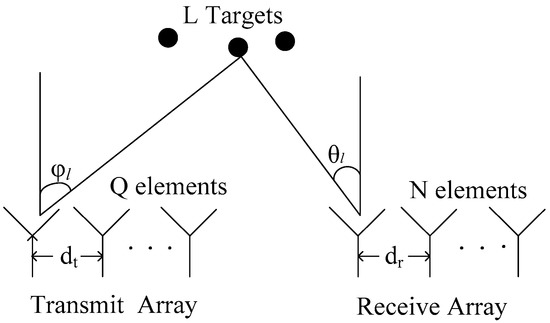
Figure 1.
Bistatic multiple-input/multiple-output (MIMO) radar system.
Each antenna transmits the linear frequency modulation signal {}. These transmitted signals can be reflected by L targets at positions {}, where denotes the DOD and denotes the DOA. In wideband sonar and radar systems, the echo from a wideband signal often contains a Doppler stretch (DS), in addition to a Doppler shift, due to the moving of the target. Thus, the received signal at the -th receive antenna can be described as follows [18]:
where is the transmitted signal by the -th transmit antenna, expressed as
where is the amplitude of the transmitted signal, and are the initial frequency and the chirp rate, respectively, is the radar cross-section (RCS), is the Doppler stretch, is the time delay, is the q-th element of the transmitter steering vector, is the -th element of the receiver steering vector, and is a sequence of independent and identically distributed (i.i.d.) isotropic complex random variables.
2.1.2. Bandpass Matched Filter
The fractional Fourier transform (FRFT) is a generalization of the FT, and can be interpreted as a rotation of the signal to any angles in the time–frequency plane [28]. The continuous FRFT of a signal with angle is defined as
where denotes the FRFT operator and is the kernel function of the fractional Fourier transform. can be expressed as
where and are the rotation angle and the frequency in the FRFT domain, respectively.
According to Equations (2) and (3), the FRFT of transmitted signal with an angle is defined as
produces the peak value when and .
The FRFT of signal with optimal angle has an obvious peak value, and the energy of concentrates in a narrow band with the central frequency of .
A -th bandpass matched filter with suitable bandwidth and central frequency is designed. Let denote the output of the -th matched filter at the -th receive antenna. represents the output of the matched filter in the FRFT domain, which corresponds to the -th transmit antenna signal in the n-th receive antenna. Through the inverse fractional Fourier transformation of , can be expressed as
where denotes the noise in the received signal .
2.2. Distribution Noise Model
Symmetric stable () processes are the subject of increased attention as a suitable framework for efficient signal processing in impulsive environments [19,20,29,30]. A “zero-centered” symmetric stable distribution is commonly described through its characteristic function as
where parameter is usually called the characteristic exponent. It can be proven that, in order to define a characteristic function for Equation (7), the values of must be restricted to the interval . When , the distribution is algebraic-tailed with tail constant , implying infinite variance. When , the SαS distribution reduces to the Gaussian distribution implying lighter-than-algebraic tails. The parameter , usually called the dispersion, is a positive constant related to the scale of the distribution. For a fixed , larger values of correspond to larger strengths of the process. It is easy to see that is, in fact, a scale parameter of the distribution.
Let be a logarithmic-order random variable. We define the geometric power of as follows [23]:
The geometric power of a symmetric stable random variable as defined in Equation (7) is given by
where is the exponential of the Euler constant.
Since the stable distribution with determines an infinite variance, we describe the signal-to-noise condition of using the generalized signal-noise-ratio (GSNR) [19,29,30], which is defined as
where is the variance of the underlying signal.
3. Sigmoid Wideband Ambiguity Function and Sigmoid Correlation
3.1. Wideband Ambiguity Function
For a joint estimation of TD and DS, Swick [31,32] suggested the application of a wideband ambiguity function (WBAF), defined by
where , and and are the time delay and Doppler stretch, respectively.
From the Schwarz inequality, we can see that
Equation (12) satisfies equality if and only if is equivalent to and when and . Since attains its maximum only at and , the estimation of TD and DS becomes a problem in locating the maximum point of , and the corresponding coordinate is the true TD and DS point and can be depicted as follows [12]:
According to Equation (11), we obtain the wideband ambiguity function of and as
where , denotes the -th target, and .
From the Schwarz inequality, we can also see that
Equation (15) holds with equality if and only if is equivalent to and when and . Since attains its maximum only at and , the estimation of TD and DS becomes a problem in locating the maximum point of , and the corresponding coordinate is the true TD and DS point .
Then, it follows directly from Equation (16) that the TD and DS are determined by
When the alpha stable distribution noise is added, this peak location algorithm may fail. The reason is that the alpha stable distribution does not have a finite -order moment and other higher-than--order moments, and the wideband ambiguity function is based on a second-order moment. Accordingly, the WBAF algorithm becomes unbounded when the received noise contains a -stable distribution noise. Therefore, we present a nonlinear transform, the Sigmoid transform, to suppress the stable distribution noise interference.
3.2. Sigmoid Transform
Sigmoid is a commonly used nonlinear transform [33,34,35]. Its definition is shown in Equation (17).
Two properties can be obtained from the analysis of the Sigmoid function transform.
Property 1.
Ifis anprocess withand, thenis a symmetric distribution with zero mean in its probability density function, and has the finite second-order moment with zero mean (referred to as a second-order moment process).
Property 2.
Set; then,has the same frequency shift as.
Since Properties 1 and 2 were proven in References [35] and [29,30], respectively, the relevant proof is skipped herein.
3.3. Sigmoid Wideband Ambiguity Function
A novel ambiguity function based on the Sigmoid transform, the Sigmoid wideband ambiguity function (referred to as Sigmoid-WBAF), , is defined as
This is the form of Sigmoid-WBAF used throughout this paper. Note that is a 2D representation of the Sigmoid correlation between and for various values of and .
We note that, in Equation (18), the limits of the integral are from to . However, in practice, we only use signals which are essentially time-limited to , meaning that the signal amplitude is negligible outside the essential duration. Thus, the practical implication of employing Equation (13) is that it will be applied only during the essential duration of . Also, in practice and for a time finite signal, can be estimated by Equation (19).
Similarly, the joint estimates of TD and DS can be obtained by
3.4. Sigmoid Correlation
For an alpha stable distribution noise environment, the conditional MUSIC algorithm performance degrades seriously and even becomes invalid because the conditional MUSIC algorithm is based on a second-order moment. To suppress the alpha stable distribution noise interference, a novel correlation function is proposed in this section.
A novel correlation based on the Sigmoid transform , referred to as the Sigmoid correlation (SC), is defined in Equation (21).
where represents a time average.
According to the properties of the Sigmoid transform, we can deduce that the properties of correlation do not change if the Sigmoid transform is applied on both signals in advance. Therefore, the Sigmoid correlation function not only has the properties of a conventional autocorrelation function, but also has a suppression ability to impulsive noise. Therefore, the Sigmoid correlation function can be used to estimate DOD and DOA in an impulsive noise environment.
3.5. Sigmoid-MUSIC Algorithm
Let
where is the vector of signals received by the array sensors, is the vector of the signals, is the vector of impulsive noise, and is the matrix of array steering vectors, in which .
The Sigmoid-MUSIC algorithm can be implemented using the following procedure:
- Step 1.
- Compute Sigmoid correlation matrices of the matrix , according to Equation (21).
- Step 2.
- Execute singular value decomposition (SVD) on , where the column vector describes the eigenvectors spanning the noise subspace.
- Step 3.
- Compute the corresponding Sigmoid-MUSIC spectrum as
- Step 4.
- The estimator of can be obtained by searching for peaks of the Sigmoid-MUSIC spectrum .
4. Joint Estimation Parameter Based on Sigmoid-WBAF and Sigmoid-MUSIC
In this section, a study of parameter estimation is made by considering signal as an example. Signal denotes the received signals corresponding to the -th target. can be expressed as
where denotes the noise in the received signal .
4.1. Estimation of TD and DS Based on Sigmoid-WBAF
According to Equations (2), (19), and (24), we can obtain the Sigmoid-WBAF of and as follows:
where is the Sigmoid wideband ambiguity function of noise and transmitted signal , and it is treated as a random interference.
Similarly, the estimators of TD and DS can be obtained from
Accordingly, the estimation of the Doppler stretch and time delay in a wideband bistatic MIMO radar was achieved via the proposed Sigmoid wideband ambiguity function. The steps involved in this process were as follows:
- Step 1.
- Present the extracted signal .
- Step 2.
- Compute the Sigmoid-WBAF function from Equation (25).
- Step 3.
- Search for the peaks of and obtain the locations of these peaks , for .
- Step 4.
- Estimate the DS and TD according to Equation (26).
4.2. Estimation of DOD and DOA Based on Sigmoid-MUSIC
In this section, DOD and DOA are estimated by employing the proposed Sigmoid-MUSIC.
The vector form of the array output can be shown as
where and are the receive and transmit steering matrices, where the receiver and transmitter steering vectors are given by and . , where is a known vector since estimated values of and are used, denotes the Kronecker Matrix product, and is a sequence of i.i.d isotropic complex random variables.
According to Equation (27), two receive subarrays and can be constructed as follows:
According to Equation (21), we can obtain the Sigmoid correlation function of the received signal vector ,
where denotes the Sigmoid autocorrelation of the matrix . Note that the correlation matrix used in this algorithm is replaced by the Sigmoid correlation matrix.
Signal is independent of noise ; thus, Equation (30) can be rewritten as
Equation (31) can then be rewritten as
where and are unitary, and the diagonal elements of the diagonal matrix are positive. The column vectors of and are the eigenvectors spanning the signal subspace and noise subspace of , respectively, with the associated eigenvalues as the diagonals of and . Since signal is independent of the noise ,
and the signal and noise subspaces are orthogonal, i.e.,
Therefore, the spatial spectrum of Sigmoid-MUSIC can be obtained based on the classical MUSIC algorithm, which can be expressed as
Searching for the spectral peak of , we can get the DOA estimator .
Similarly, we can obtain the Sigmoid correlation function of the received signal vector according to Equations (29)–(32) as
where and are unitary, and the diagonal elements of the diagonal matrix are positive. The column vectors of and are the eigenvectors spanning the signal subspace and noise subspace of , respectively, with the associated eigenvalues as the diagonals of and .
Therefore, the Sigmoid-MUSIC algorithm was employed on matrix ; we can also obtain the spatial spectrum of Sigmoid-MUSIC for the subarray as
Searching for the spectral peak of , we can get the DOD estimator .
Accordingly, the estimation of DOD and DOA in a wideband bistatic MIMO radar was achieved via the proposed Sigmoid-MUSIC algorithm. The steps involved in this process were as follows:
- Step 1.
- Construct two matrices and .
- Step 2.
- Substitute the time average with the statistic average, two Sigmoid correlation matrices and are then constructed according to Equation (21).
- Step 3.
- Apply the singular value decomposition (SVD) to and , where the column vectors and are formed from the eigenvectors spanning the noise subspace.
- Step 4.
- Compute the corresponding Sigmoid-MUSIC spectra and from Equations (36) and (37).
- Step 5.
- The DOA and DOD estimates can be obtained by identifying the peaks of the spatial spectra and .
5. Analysis of Sigmoid-WBAF and Sigmoid-MUSIC
5.1. Boundness of Sigmoid-WBAF
According to the properties of the Sigmoid transform, the SαS process with can be transformed to a second-order moment process by the Sigmoid transform. Therefore, is bounded for the process because it is only involved with under the noise. Furthermore, the transformation does not change the estimation results of the time delay and Doppler frequency shift. Therefore, the Sigmoid-WBAF method can be used to estimate the parameters of wideband echoes under stable distribution noise.
5.2. Feasibility Analysis of Sigmoid-WBAF
Simulation results and theoretical analyses illustrated that the Sigmoid transform does not change the modulation characteristics of the signal [29]. Therefore, the characteristics of WBAF do not change if the Sigmoid transform is applied to the signal in advance. This simulation result is illustrated in Figure 2 to verify this property. Figure 2 shows the spectra of WBAF and Sigmoid-WBAF.
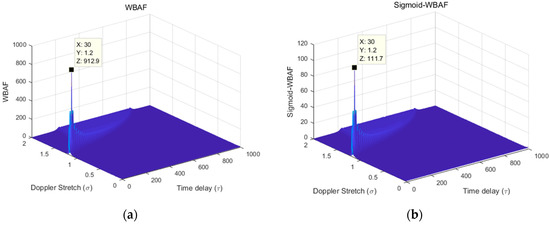
Figure 2.
The spectra of (a) wideband ambiguity function (WBAF) and (b) Sigmoid-WBAF.
From Figure 2, the WBAF of the LFM signal and Sigmoid-WBAF of the LFM signal have the same peak location in the WBAF domain. Therefore, the parameters of the Doppler stretch and time delay can be estimated by searching for the peak of Sigmoid-WBAF.
5.3. The Cramer–Rao Bound
In this section, we derive a novel explicit expression for the exact Cramer–Rao Bound (CRB) on the accuracy of estimating the signal model parameters [29].
The received signal can be expressed as
where
and , .
The four parameters to be estimated are the time delay , the Doppler stretch , the DOD , and the DOA , which form the parameter vector as .
The element at in the Fisher information matrix (FIM) for estimating the vector can be depicted as follows [21,32,36,37,38]:
where denotes the number of snapshots, and .
For Equation (41), we may calculate the partial derivations.
where is the -th column of the identity matrix (i.e., vector containing one in the -th position and zeroes elsewhere). The following notations are introduced:
where is the Schur–Hadamard matrix product and is Khatri–Rao matrix product.
From Equations (42)–(44), we obtain that
where .
Using Equation (46), the following explicit expressions for the blocks of the FIM were derived for the proposed signal model:
where
The expression for the CRB, shown in Equation (65), is obtained by substituting Equations (46)–(64) into Equation (39).
5.4. Complexity Analysis
In this section, we evaluate the computation complexity of the proposed method.
5.4.1. Doppler Stretch and Time Delay
The method based on the WBAF can estimate Doppler stretch and time delay by searching the peak of the WBAF. Denoting the number of snapshots, time delay, and Doppler stretch to be searched as , , and , respectively, the computational complexity of the WBAF is then around [39,40]. The computation complexity of the FLOS-WBAF algorithm is . The parameter estimation based on Sigmoid-WBAF method is a two-step process. The first step carries the Sigmoid transformation and the second step computes the WBAF. Accordingly, the computational complexity of the Sigmoid-WBAF algorithm is . Through the computational complexity analysis, the Sigmoid-WBAF method not only has the same computation complexity as the WBAF method and FLOS-WBAF method, but also can suppress impulsive noise interference and does not need any a priori knowledge of the noise.
5.4.2. DOD and DOA
The computational complexities of the proposed Sigmoid-MUSIC, MUSIC, and FLOM-MUSIC algorithms were compared. All these methods include the eigen decomposition step which is represented by the term . The computation of samples of the MUSIC spectrum function requires . Thus, the computational complexity of spectral MUSIC is , where denotes the number of the received antennas, and denotes the number of the targets [41]. The computational complexity of FLOM-MUSIC is also . The Sigmoid-MUSIC method needs to carry the Sigmoid transformation in advance. Thus, the computational complexity of Sigmoid-MUSIC is .
Through the computational complexity analysis, we can deduce that the Sigmoid-MUSIC method not only has the same computation complexity as other methods, but also can suppress impulsive noise interference and does not need any a priori knowledge of the noise.
6. Simulation Results
We performed simulation experiments to assess the relative performance of the different methods, including the WBAF [12], FLOS-WBAF [18], and Sigmoid-WBAF to estimate TD and DS; and the conditional MUSIC [21], FLOM-MUSIC [22], FLOM-SC-SSF [14], -MUSIC [24], and Sigmoid-MUSIC to estimate DOD and DOA, under stable noise condition.
The wideband bistatic MIMO radar was composed of transmit antennas and receive antennas. Suppose that the target is located at the positions , ; DS and TD are , , , , respectively, where the sampling frequency is . The root-mean-square error (RMSE) is defined as
where and are the estimations of and , and is the total number of successful runs. For each simulation, the numbers of Monte Carlo runs and snapshots were 300 and 1000, respectively.
6.1. Simulation 1: Spectra of WBAF, FLOS-WBAF, and Sigmoid-WBAF for a Single Estimation for Two Targets
In this simulation, we discuss the estimation results obtained from the WBAF, FLOS-WBAF, and Sigmoid-WBAF for two targets in the Gaussian noise and impulsive noise environment. The corresponding results are illustrated in Figure 3, Figure 4 and Figure 5.
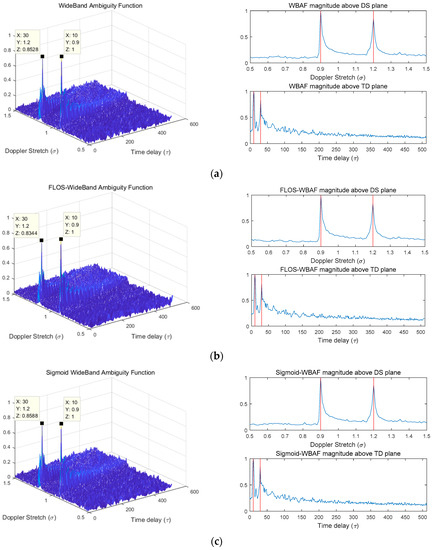
Figure 3.
The normalized spectra of WBAF, FLOS-WBAF, and Sigmoid-WBAF for Gaussian noise with . (a) The three-dimensional (3D) plot of WBAF and its Doppler stretch (DS) and time delay (TD) section planes; (b) the 3D plot of FLOS-WBAF with p = 1.1 and its DS and TD section planes; (c) the 3-D plot of Sigmoid-WBAF and its DS and TD section planes.
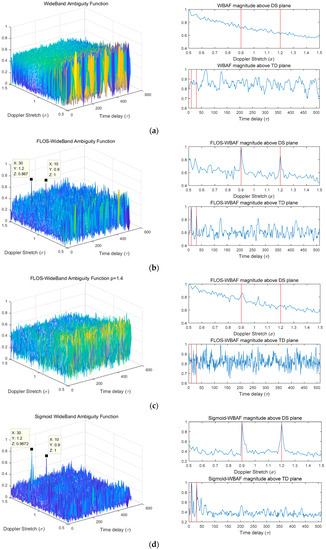
Figure 4.
The normalized spectra of WBAF, FLOS-WBAF, and Sigmoid-WBAF for impulsive noise with and . (a) The 3D plot of WBAF and its DS and TD section planes; (b) the 3D plot of FLOS-WBAF with p = 1.1 and its DS and TD section planes; (c) the 3D plot of FLOS-WBAF with p = 1.4 and its DS and TD section planes; (d) the 3D plot of Sigmoid-WBAF and its DS and TD section planes.
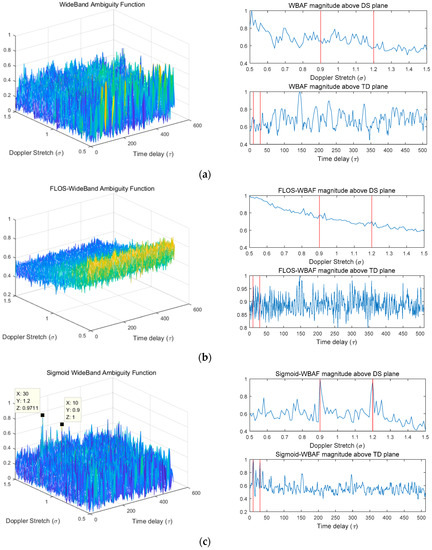
Figure 5.
The normalized spectra of WBAF, FLOS-WBAF, and Sigmoid-WBAF for impulsive noise with and . (a) The 3D plot of WBAF and its DS and TD section planes; (b) the 3D plot of FLOS-WBAF with p = 1.1 and its DS and TD section planes; (c) the 3D plot of Sigmoid-WBAF and its DS and TD section planes.
In the Gaussian noise, all three methods revealed two clear peaks, as illustrated in Figure 3. However, from Figure 4 and Figure 5, it can clearly be seen that the WBAF algorithm failed for the impulsive noise case. The reason is that the WBAF method does not have the ability to suppress impulsive noise. On the other hand, the FLOS-WBAF algorithm, combining the fractional lower-order statistics theory with the wideband ambiguity function, can effectively suppress the alpha stable noise interference, where clear peaks were obtained for the impulsive noise case with , , and . However, FLOS-WBAF failed to obtain the correct spectrum peaks for impulsive noise with and , mainly due to the fact that the fractional lower-order moment value was not appropriate, as illustrated in Figure 4. Based on the fractional lower-order statistics theory, the characteristic exponent of the noise must be estimated to ensure or . The methods employing the FLOS theory cannot accurately estimate the parameters if there is no a priori knowledge of the characteristic exponent. Furthermore, the algorithm’s performance degrades seriously and even becomes invalid when the fractional lower-order moment value is outside the specified range. On the contrary, Sigmoid-WBAF had clear peaks regardless of the value of the fractional lower-order moment . As illustrated in Figure 5, FLOS-WBAF failed to obtain the correct peaks for impulsive noise with , , and . However, Sigmoid-WBAF had clear peaks. The reason is that the Sigmoid transform can suppress impulsive noise better than any of the FLOS-type methods, including FLOS-WBAF.
6.2. Simulation 2: Spectrum Performances of the Four Algorithms
In this simulation, the generalized signal-to-noise ratio was set to GSNR = 0 dB and the characteristic exponent was set to 1.2.
Figure 6 shows the spatial spectra of the MUSIC, FLOM-MUSIC, -MUSIC, FLOM-SC-SSF, and Sigmoid-MUSIC algorithms. The performance of the MUSIC algorithm degraded seriously under the α stable distribution noise. Although the spatial spectra of the FLOM-MUSIC, FLOM-SC-SSF, and -MUSIC algorithms had two spectrum peaks, the spectrum peak of FLOM-MUSIC showed a deviation from the true location, and the spectrum peaks of FLOM-SC-SSF and -MUSIC did not have two spiked peaks. The Sigmoid-MUSIC algorithm based on Sigmoid transform can suppress the impulse noise interference, especially for low GSNR. Therefore, the Sigmoid-MUSIC algorithm had a more accurate spectrum peak and better estimation performance.
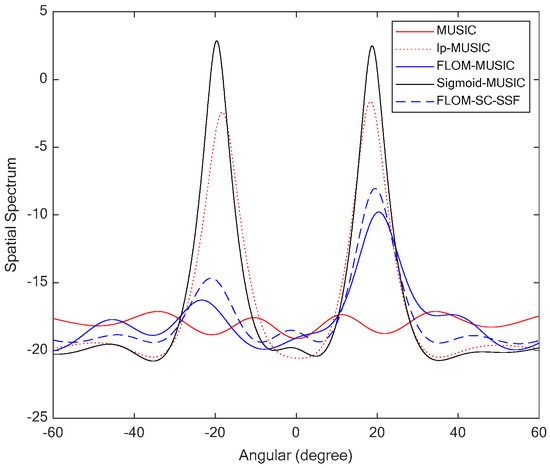
Figure 6.
Spatial spectra of the four algorithms.
6.3. Simulation 3: Generalized Signal-to-Noise Ratio (GSNR)
In this simulation and to evaluate the performances of TD and DS, the characteristic exponent was set to , and the fractional lower-order moment was set to and for FLOS-WBAF. The parameter p was set to for FLOM-MUSIC while estimating the performances of DOD and DOA. The root CRBs and RMSEs of parameter estimation under different GSNRs are shown in Figure 7.
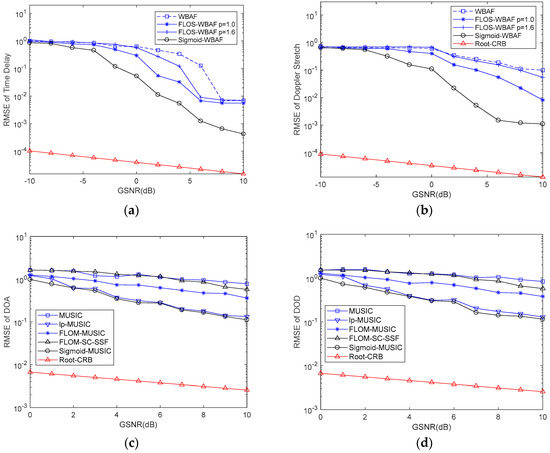
Figure 7.
Root-mean-square errors (RMSEs) of parameters versus generalized signal-to-noise ratio (GSNR). (a) RMSE of the time delay; (b) RMSE of the Doppler stretch; (c) RMSE of the direction-of-departure (DOD); (d) RMSE of the direction-of-arrival (DOA).
From Figure 7a,b, we can find that the WBAF method had poor estimation performance. The estimation performance of FLOS-WBAF was affected by the fractional-lower order moment . The estimation performance of FLOS-WBAF with had poor performance. The RMSE of Sigmoid-WBAF was obviously lower than that of FLOS-WBAF and WBAF when . When , the performance of Sigmoid-WBAF was similar to the other methods. From Figure 7c,d, the conventional MUSIC method was inferior to the other methods. For low GSNRs, both Sigmoid-MUSIC and -MUSIC could get lower RMSEs than other methods; however, Sigmoid-MUSIC yielded more accurate DOA estimation results. Therefore, the estimation performance of the proposed method was superior to other methods. As shown in Figure 7, the root CRB decreased with increasing GSNR. Moreover, the root CRB could be apparently affected by the GSNR for a given characteristic exponent .
6.4. Simulation 4: Characteristic Exponent
In this simulation and to measure the estimation performances of TD and DS, the fractional lower-order moment was set to and for FLOS-WBAF. The GSNR was set to . While evaluating the performances of DOD and DOA, the fractional lower-order moment was set to for FLOM-MUSIC. The root CRBs and RMSEs on parameter estimation under different characteristic exponents are shown in Figure 8.
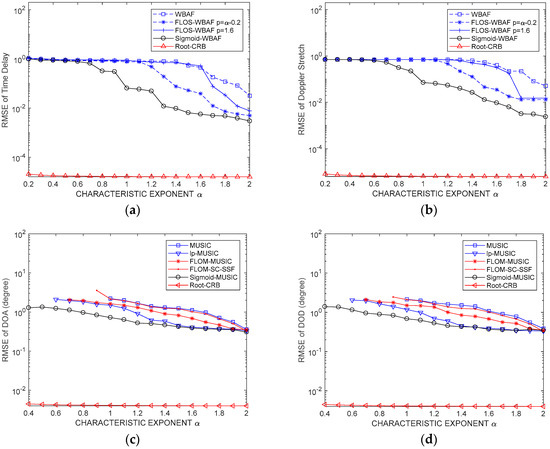
Figure 8.
RMSEs of the parameters versus characteristic exponent . (a) RMSE of the time delay; (b) RMSE of the Doppler stretch; (c) RMSE of the DOD; (d) RMSE of the DOA.
From Figure 8a,b, we can find that WBAF and FLOS-WBAF with had poor estimation performance. When , the estimation performance of Sigmoid-WBAF was obviously better than that of the FLOS-WBAF method with . Although FLOS and Sigmoid transform can both suppress impulsive noise, the suppression capacity of FLOS was not enough because for any . For this reason, large outliers of impulsive noise cannot be restrained sufficiently when the impulsiveness is extremely intensive. In contrast, the Sigmoid function can be assumed to be approximately linear. can reach significant suppression when is far away from zero. Because the signals are often assumed to have a zero-mean value, the Sigmoid function can be used to suppress the outliers [42]. For any , . Therefore, the Sigmoid function suppresses the outliers much better than FLOS, and the estimation performance of the Sigmoid-WBAF algorithm was better than that of the FLOS-WBAF algorithm. From Figure 8c,d, we can find that the conventional MUSIC method was inferior to other methods. For highly impulsive noise, Sigmoid-MUSIC could get more accurate DOA estimation results. When , Sigmoid-MUSIC and -MUSIC could obtain smaller RMSEs than other methods. When , the stable distribution became a Gaussian distribution. As shown in Figure 8, in this case, the three algorithms had similar performance. As illustrated in Figure 8, root CRB decreased with increasing characteristic exponent ; however, root CRB was less affected by for a given GSNR.
7. Conclusions
In this paper, we considered the problem of parameter estimation for a wideband bistatic MIMO radar in impulsive noise environments. Based on the WBAF and MUSIC methods, we developed a novel method without any a priori knowledge of the noise. A robust estimator, termed Sigmoid-WBAF, was employed to estimate the time delay and Doppler stretch in the presence of impulsive noise. Then, the properties of the Sigmoid transform and Sigmoid correlation were presented. A novel MUSIC-based Sigmoid correlation (Sigmoid-MUSIC) was developed to estimate DOD and DOA. Furthermore, the boundness of Sigmoid-WBAF to the symmetric alpha stable () noise, the feasibility analysis of Sigmoid-WBAF, and complexity analysis of Sigmoid-WBAF and Sigmoid-MUSIC algorithms were presented to evaluate the performance of the proposed method. In addition, the Cramér–Rao bound for parameter estimation was derived and computed in closed form, which showed that better performance was achieved. Lastly, comprehensive simulations were carried out to evaluate the performance of different methods. Simulation results and theoretical analyses showed that the proposed Sigmoid-WBAF and Sigmoid-MUSIC had better estimation performance, especially in highly impulsive noise environments.
Author Contributions
All the authors made significant contributions to this work. L.L. proposed the approach, prepared experimental data, and analyzed experimental results; N.H.Y. provided advice for the preparation and revision of the work; X.S. performed the experiments and revised the paper.
Funding
This work was partly supported by the National Natural Science Foundation of China under Grants 61401055 and 61671105, the PhD Programs Foundation of Liaoning Province of China 20170520421, and the China Scholarship Fund Program.
Conflicts of Interest
The authors declare no conflicts of interest.
References
- Li, J.; Stoica, P. MIMO radar with colocated antennas: Review of some recent work. IEEE Signal Process. Mag. 2007, 24, 106–114. [Google Scholar] [CrossRef]
- Chan, F.; So, H.; Huang, L.; Huang, L. Parameter estimation and identifiability in bistatic multiple-input multiple-output radar. IEEE Trans. Aerosp. Electron. Syst. 2015, 51, 2047–2056. [Google Scholar] [CrossRef]
- Li, J.; Stoica, P. MIMO Radar Signal Processing; Wiley: New York, NY, USA, 2008. [Google Scholar]
- Yeo, K.; Chung, Y.; Yang, H.; Kim, J.; Chung, W. Reduced-dimension DOD and DOA estimation through projection filtering in bistatic MIMO radar with jammer discrimination. IET Radar Sonar Navig. 2017, 11, 1228–1234. [Google Scholar] [CrossRef]
- Yunhe, C. Joint estimation of angle and Doppler frequency for bistatic MIMO radar. Electron. Lett. 2010, 46, 170–172. [Google Scholar] [CrossRef]
- Yao, B.; Wang, W.; Yin, Q. DOD and DOA estimation in bistatic non-uniform multiple-input multiple-output radar systems. IEEE Commun. Lett. 2012, 16, 1796–1799. [Google Scholar] [CrossRef]
- Jiang, H.; Zhang, J.; Wong, K. Joint DOD and DOA estimation for bistatic MIMO radar in unknown correlated noise. IEEE Trans. Veh. Technol. 2015, 64, 5113–5125. [Google Scholar] [CrossRef]
- Bencheikh, M.; Wang, Y. Joint DOD-DOA estimation using combined ESPRIT-MUSIC approach in MIMO radar. Electron. Lett. 2010, 46, 1081–1083. [Google Scholar] [CrossRef]
- Li, J.F.; Jiang, D.F.; Zhang, X.F. DOA estimation based on combined unitary ESPRIT for coprime MIMO radar. IEEE Commun. Lett. 2017, 21, 96–99. [Google Scholar] [CrossRef]
- Xie, R.; Liu, Z. Multi-target localization based on polynomial rooting for bistatic MIMO radar. J. Electron. Inf. Technol. 2010, 32, 2197–2220. [Google Scholar] [CrossRef]
- Shi, J.F.; Wang, K.R. Joint estimation of Doppler and multipath time delay of wideband echoes for LFM pulse radar based on cyclic correlation. J. Electron. Inf. Technol. 2008, 30, 1736–1739. [Google Scholar] [CrossRef]
- Qu, J.; Kon, M.W.; Luo, Z.Q. The estimation of time delay and Doppler stretch of wideband signals. IEEE Trans. Signal Process. 1995, 43, 904–916. [Google Scholar]
- Ma, N.; Goh, J.T. Ambiguity-function-based techniques to estimate DOA of broadband chirp signals. IEEE Trans. Signal Process. 2006, 54, 1826–1839. [Google Scholar]
- Xu, G.; Kailath, T. Direction-of-arrival estimation via exploitation of cyclostationary a combination of temporal and spatial processing. IEEE Trans. Signal Process. 1992, 40, 1775–1786. [Google Scholar] [CrossRef]
- You, G.H.; Qiu, T.S.; Lan, T. DOA estimation algorithm of wideband cyclostationary signals in impulsive noise environment. J. Data Acquis. Process. 2012, 27, 399–403. (In Chinese) [Google Scholar]
- Chen, H.W.; Zhao, J.W. Wideband MVDR beamforming for acoustic vector sensor linear array. IEE Proc. Radar Sonar Navig. 2004, 151, 158–162. [Google Scholar] [CrossRef]
- Yoon, Y.S.; Kaplan, L.M.; McClellan, J.H. Tops: New DOA estimator for wideband signals. IEEE Trans. Signal Process. 2006, 54, 1977–1989. [Google Scholar] [CrossRef]
- Li, L.; Qiu, T. A novel method for parameter estimation based on wide-band ambiguity function in bistatic MIMO radar system in impulsive noise environment. Acta Electron. Sin. 2016, 44, 2842–2848. (In Chinese) [Google Scholar]
- Shao, M.; Nikias, C.L. Signal processing with fractional lower order moments: Stable processes and their applications. Proc. IEEE 1993, 81, 986–1010. [Google Scholar] [CrossRef]
- Tsakalides, P.; Nikias, C.L. The robust covariation-based MUSIC (ROC-MUSIC) algorithm for bearing estimation in impulsive noise environments. IEEE Trans. Signal Process. 1996, 44, 1623–1633. [Google Scholar] [CrossRef]
- Stoica, P.; Arye, N. MUSIC maximum likelihood, and cramer-rao bound. IEEE Trans. Acoust. Speech Signal Process. 1989, 37, 720–741. [Google Scholar] [CrossRef]
- Liu, T.; Mendel, J.M. A subspace-based direction finding algorithm using fractional lower order statistics. IEEE Trans. Signal Process. 2001, 49, 1605–1613. [Google Scholar]
- Gonzalez, J.G.; Paredes, J.L.; Arce, G.R. Zero-order statistics: A mathematical framework for the processing and characterization of very impulsive signals. IEEE Trans. Signal Process. 2006, 54, 3839–3851. [Google Scholar] [CrossRef]
- Zeng, W.J.; So, H.C.; Huang, L. lp-MUSIC: Robust direction-of-arrival estimator for impulsive noise environments. IEEE Trans. Signal Process. 2013, 61, 4296–4308. [Google Scholar] [CrossRef]
- Li, L.; Qiu, T.S.; Shi, X.F. Parameter estimation based on fractional power spectrum density in bistatic MIMO radar system under impulsive noise environment. Circuits Syst. Signal Process. 2016, 35, 3266–3283. [Google Scholar] [CrossRef]
- Li, S.; He, R.X.; Lin, B.; Sun, F. DOA estimation based on sparse representation of the fractional lower order statistics in impulsive noise. IEEE/CAA J. Autom. Sin. 2017, 99, 1–9. [Google Scholar] [CrossRef]
- Li, L.; Qiu, T.S. Parameter dynamic estimation in near-field bistatic MIMO radar system. J. Commun. 2015, 10, 882–888. [Google Scholar] [CrossRef]
- Kang, X.J.; Tao, R.; Zhang, F. Multiple-parameter discrete fractional transform and its applications. IEEE Trans. Signal Process. 2016, 64, 3402–3417. [Google Scholar] [CrossRef]
- Li, L.; Younan, N.H.; Shi, X. A novel parameter estimation method based on a tuneable sigmoid in alpha-stable distribution noise environments. Sensors 2018, 18, 3012. [Google Scholar] [CrossRef] [PubMed]
- Li, L.; Qiu, T. A novel phase parameter estimation method of quadratic FM signal based on Sigmoid fractional ambiguity function in impulsive noise environment. AEU Int. J. Electron. Commun. 2018, 93, 268–276. [Google Scholar] [CrossRef]
- Swick, D.A. An Ambiguity Function Independent of Assumption about Bandwidth and Carrier Frequency; NRL Report 6471; Naval Research Laboratory: Washington DC, USA, 1966. [Google Scholar]
- Swick, D.A. A Review of Wide-Band Ambiguity Function; NRL Report 6994; Naval Research Laboratory: Washington, DC, USA, 1969. [Google Scholar]
- Brodersen, K.H.; Daunizeau, J.; Mathys, C.; Chumbley, J.R.; Buhmann, J.M.; Stephan, K.E. Variational Bayesian Mixed-Effects Inference for Classification Studies. Neuroimage 2013, 76, 345–361. [Google Scholar] [CrossRef]
- Lang, H.; Zhang, J.; Zhang, X.; Meng, J. Ship classification in SAR image by joint feature and classifier selection. IEEE Geosci. Remote Sens. Lett. 2016, 13, 212–216. [Google Scholar] [CrossRef]
- Qiu, T.; Wang, H.; Zhang, Y.; Bao, H. Non-linear transform-based robust adaptive latency change estimation of evoked potentials. Meth. Inf. Med 2002, 41, 331–336. [Google Scholar]
- Gershman, A.B.; Pesavento, M.; Amin, M.G. Estimating parameters of multiple wideband polynomial-phase sources in sensor arrays. IEEE Trans. Signal Process. 2001, 49, 2924–2934. [Google Scholar] [CrossRef]
- Swindlehurst, A.L.; Stoica, P. Maximum likelihood methods in radar array signal processing. IEEE Proc. 1998, 86, 421–441. [Google Scholar] [CrossRef]
- Bekkerman, I.; Tabrikian, J. Target detection and localization using MIMO radars and sonars. IEEE Trans. Signal Process. 2006, 54, 3873–3883. [Google Scholar] [CrossRef]
- Xiao, X.; Guo, F.; Feng, D. Low-complexity methods for joint delay and Doppler estimation of unknown wideband signals. IET Radar Sonar Navig. 2018, 12, 398–406. [Google Scholar] [CrossRef]
- Jiang, J.; Wang, X.; Duan, F.; Yan, H.; Hua, B.; Ma, S.; Deng, C.; Bu, L.; Sun, Z.; Li, C. An sufficient algorithm for WBAF estimation absed on linear interpolation and its estimation error. Appl. Acoust. 2018, 142, 44–52. [Google Scholar] [CrossRef]
- Rubsamen, M.; Gershman, A. Direction-of-arrival estimation for nonuniform sensor arrays: Form manifold separation to Fourier domain MUSIC methods. IEEE Trans. Signal Process. 2009, 57, 588–599. [Google Scholar] [CrossRef]
- Yu, L.; Qiu, T.S.; Luan, S.Y. Robust joint estimation for time delay and Doppler frequency shift based on generalized sigmoid cyclic cross-ambiguity function. IET Radar Sonar Navig. 2017, 11, 721–728. [Google Scholar]
© 2019 by the authors. Licensee MDPI, Basel, Switzerland. This article is an open access article distributed under the terms and conditions of the Creative Commons Attribution (CC BY) license (http://creativecommons.org/licenses/by/4.0/).